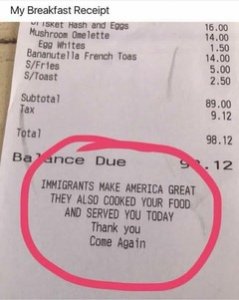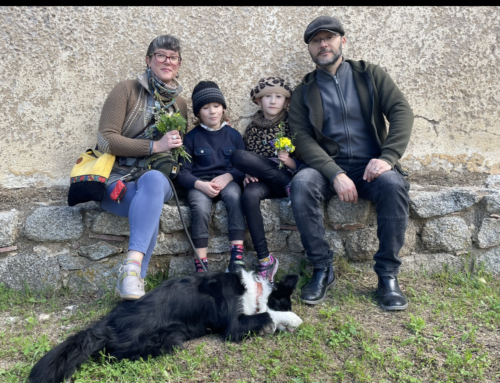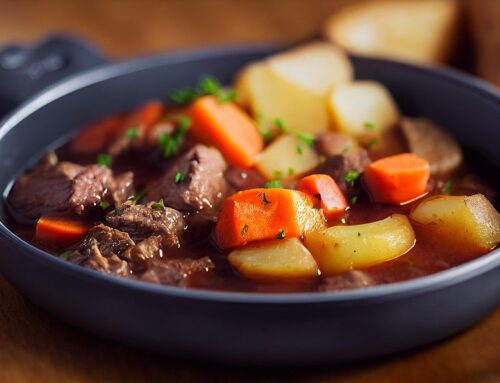 I have a family of five – three adults and two children, aged 5 and 2. We eat on a budget of about 70 € EUR a week, which is around $80 per week, averaging to less than $400 USD/month.
I have a family of five – three adults and two children, aged 5 and 2. We eat on a budget of about 70 € EUR a week, which is around $80 per week, averaging to less than $400 USD/month.
I made a bold statement, which created quite a stir on a recent Facebook post:
The intent of the meme was the beautiful sentiment about immigrants. I said it was something Anthony Bourdain might say. However, what my eye couldn’t help catch was the total bill amount. It looks like 3 people had breakfast out and it cost almost $100 US dollars.
I exclaimed that this was more than my grocery budget for 6 weeks.
I Was Wrong
Well, folks, I will share with you something that everyone who knows me in real life is aware of, I have Dyscalculia or “math dyslexia”. So trying to calculate monthly grocery costs in my brain, especially when I was agitated at the thought of spending almost $100 for breakfast; I got it wrong.
What I should have said is that oftentimes I spend that much on groceries for 3 weeks, which is still a bold statement, given that the average American family on a “thrifty plan” budget (the lowest), spends about $720 per month, and those on a “liberal plan” (the highest), spends about $1400. (From the USDA Cost of Food at Home).
Yes, in Italy food is cheaper, as you will see further in the post when I share my latest shopping receipt. But you can still use all of the tips in this post to cut down on your food budget.
“All food should be honored and that means not allowing it become waste rather we breathe new life into it and allow it to shine.” ~Jenn Campus
Ancestral Peasant Food
There is a lot of food guilt in the United States. I think it is because so many people have lost touch with their ancestors and how they ate. One of the beautiful things about America is that it is so diverse, yet that has lead to the loss of traditional foodways for many, which is a shame.
Food is one of the fundamental components of culture, when we lose that, we lose a part of ourselves, which can make one feel rudderless and therefore more susceptible to every new diet trend that comes on the market. Reclaim traditional knowledge through finding out what your ancestors ate.
(Read about how Sardinia helped me deal with my unhealthy relationship with food here)
When my chips are down, times are tough and money is tight, I look to the legacy that my grandparents left behind for advice. My grandparents and great grandparents on my mom’s side were salt of the earth people, mostly farmers, immigrants from southern Italy. My grandmother cooked every meal. She shopped for items on sale and created a pantry of staples. She prepared simple meals.
Even if your ancestors were wealthy, every culture has their own version of peasant food. Look for soups, salads and grain-based recipes. Those are usually the cheapest and most filling options. Learn some of those dishes from your heritage prepare them with love and serve them to your family. That is a recipe for healing.
mage=”31337″
I also look to where I live for guidance. The area where we live, the land itself also provides answers. The questions to ask are: what is in season? What products are produced and grow easily here? In Sardinia we are blessed with a long growing season, and a plethora of wild foods. Visit farmers markets. When it comes to eating good wholesome food, meeting area farmers is so important. They want to build a strong and loyal customer base, and you need good food. Work together.
Learn what grows in your area and understand your town’s laws on foraging for wild foods. The land provides much, and you can share in its bounty. (*Please read up on sustainable foraging practices, first*). Foraging for food also brings you back to lessons learned from our ancestors.
(See what grows in our neighborhood in Sardinia, here)
Combine the traditional recipes and foodways of your ancestors, and what the land where you reside can provide. Use this combination of factors as the basis for how and what you cook.
If you need more inspiration, please check out these recipes and posts:
- Bread Salad For the Modern Peasant
- Medieval Chickpea Flour Pancakes
- Eat Like an Italian: The Real Mediterranean Diet
How I Do It
image=”31342″
Now back to my budget, food costs and how I make it all work. Here is my most recent grocery receipt. This food lasted three weeks. I will give a run-down of what these items are in English, and their equivalent cost in USD.
| White flour, 1kg – 41¢ Durum wheat flour, 1 kg – 81¢ White flour, 1 kg – 41¢ Pasta, 500g – 46¢ Durum wheat flour, 1 kg – 81¢ Pasta, 500g – 46¢ Passata (tomato sauce, plain), 1000g – 76¢ Pasta, 500g – 46¢ Ground coffee, 500g- $1.15 Mayo, 300ml – $1.05 Napkins (60) – $1.63 Gluten-free pasta, 500g – $1.40 Pesto 190g – 93¢ Red wine vinegar, 1L – 76¢ Jam, 360g – $1.28 Rose Wine, 5L – $3.15 EVOO, 1L – $4.69 Red pesto, 190g – 93¢ White wine, 750ml – $1.99 |
Jarred anchovies, 80g – $1.63 Can of Tuna, 160g – $1.28 White beans, 400g – 41¢ Rice, 200 kg – $1.75 Ready made Polenta, 1 kg – 58¢ Chickpeas, 400g – 41¢ Lentils, 400 g – 41¢ Turkey hot dogs, 250g – 69¢ Turkey hot dogs, 250g – 69¢ Fagiolini Fin.– Frozen green beans, 600g – $1.16 Frozen peas, 1000g – $1.40 Frozen grilled vegetables, 450g – $1.75 Fresh meat tortellini, 500g – $1.75 Goat milk ricotta, (about 2/3 pound) $2.44 Vanilla yogurt, 500 g – 93¢ Vanilla yogurt, 500g – 93¢ Natural yogurt (2), 500g – 81¢ each Fresh sausage links, 7 pieces – $4.51 |
Fresh ground pork (about a pound) – $2.86 Grana Padano cheese, (about ½ pound) – $2.37 Yellow plums, 1kg – $1.52 Wheel of sheep milk cheese (about 1 ½ pounds) – $7.76 Bunch of celery – $1.28 Mortadella .578kg – $2.61 Apricots, 1kg – $1.49 Garlic, 200 g (5 heads) – $1.99 Sandwich bread, 330g – 41¢ Fennel, 1kg – $1.46 1 Eggplant – 70¢ New Potatoes, 4 kg – $4.22 Whole Cantaloupe – $1.49 Zucchini 500g – 96¢ Iceberg lettuce – 93¢ 2 Cucumbers– 80¢ Bunch of bananas – 63¢ |
Shopper Ortofr. Bio is the cost of the biodegradable produce bags they offer in the produce section
Total : 71.99 € EUR = $84.15
Full Disclosure
I also had a 3kg bag of pasta in the pantry and a jar of antipasto marinated vegetables. These were also used up during the 3-week timeframe. The 3 kg bag of pasta cost around 3€ EUR.
This is not easy by any means, and one day when I have a larger food budget, I will feel lighter and spend it happily. But I know that many of us are struggling today, and if this post helps just a few people eat better on a very tight budget, then I am happy.
I cook three meals a day, every day. We don’t eat out, unless you count picnics, and that is with food we brought from home, usually sandwiches, and some fruit.
We drink coffee at home.
We don’t snack; we eat the three meals a day and maybe twice a month enjoy an ice cream or coffee out if we can afford it.
I make all our meals from scratch and bake my own bread. I also make all my own broths and stocks. If I had an immersion blender, I would probably make all our condiments too. (Damn, I miss hummus). And yes, I do work and chase kids all day.
Kids get first dibs. The kids get priority when it comes to food quality and quantity. They get more meat, and dairy, and eat lots of fruit. They also get snacks whenever they need them.
We eat a lot of carbs – pasta, rice and potatoes. I use these as the basic foundation for every meal. This allows me to stretch the other more expensive ingredients, like proteins and dairy.
Money Saving Tips
- Learn to Cook. This is essential. Find the peasant food of your people and learn some of the recipes. Make them for your family, with love.
- Find recipes that don’t take a long time to make, or very little active time.
- Plan Meals. Then shop for only those items at the store.
- Buy In Season. Plan seasonal meals. Seasonal food is always cheaper than food that is harder to come by.
- Buy on Sale. Get to know the weekly fliers from local groceries stores, so you can plan your meals based on what is on sale that week.
- Eat Less Meat. Meat is expensive. Use it as a condiment to flavor food, but not as the main part of your meal.
- Condiments are Key. Sauces, herbs, spices and condiments really turn homely foods into feasts. A little goes a long way, and can make the same ingredients, like beans and rice or pasta taste vastly different based on what condiments you use when you prepare them.
The Modern Peasant
image=”31338″
The first course will go into much greater detail on how to eat on a very tight budget, much more than I can go into in a blog post.
However, I am committed to share easy, delicious, healthy and traditional recipes on my blog at regular intervals for those who cannot afford a course on it.
Why do I call myself a peasant instead of just plain ‘ol poor? It hearkens to days past and allows me to proudly draw on the wisdom and traditions of the women who have gone before me to find ways to live with little, yet feel content and provided for; making the most of available resources.
Modern Peasants live or long for a simple life, whether it is out of financial need or because they want to preserve what resources they have. Sometimes it is because they want to unplug a little from this fast paced world and live with more care for the earth, or believe that living a little more in tune with how their ancestors lived enriches their lives.
To learn more about the Modern Peasant life, check out my about page. And my new Modern Peasant group on Facebook where I hope to foster a community that shares all kinds of ideas that appeal to the modern peasant, like foraging, cooking on an open fire, making herbal medicines, beauty treatments and natural household cleaners, gardening, etc. If these topics interest you, I hope you will join us there! That is also the place you can keep up on my progress and release date for the online course.
Join “The Modern Peasant“ Group on Facebook”: https://www.facebook.com/modernpeasants







Leave a Reply